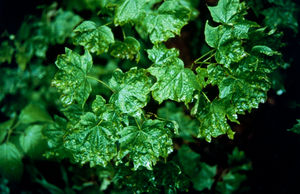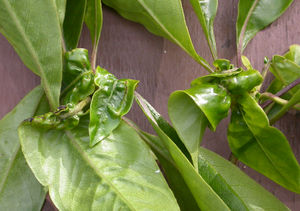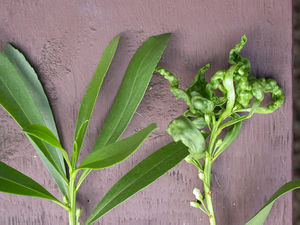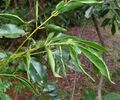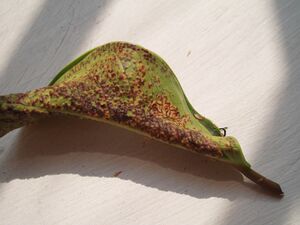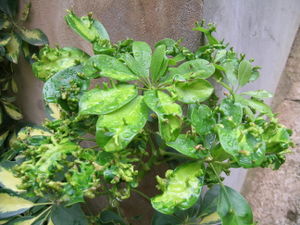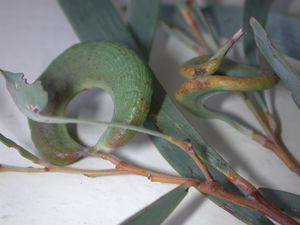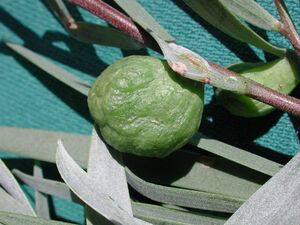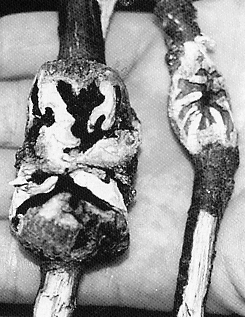Difference between revisions of "Thrips and galls"
| (43 intermediate revisions by 2 users not shown) | |||
| Line 1: | Line 1: | ||
Laurence Mound, CSIRO Ecosystems Sciences, Canberra | Laurence Mound, CSIRO Ecosystems Sciences, Canberra | ||
[[File:SugarMapleLeafDamage-1-.jpg|thumb|right|Picture 1. Sugar maple leaf damage]] | [[File:SugarMapleLeafDamage-1-.jpg|thumb|right|Picture 1. Sugar maple leaf damage]] | ||
| − | Thrips feed on plants by sucking out the contents of individual cells, and this process of | + | Thrips feed on plants by sucking out the contents of individual cells, and this process of killing cells can result in extensive damage to leaves and to flowers. An extreme example of such feeding damage sometimes occurs on the young leaves of sugar maple trees in north east America caused by ''Taeniothrips inconsequens'' (Picture 1.). The effects of feeding by this thrips can be so severe that leaves are killed, and in a severe infestation whole trees are defoliated and unproductive for a season. In contrast, to this reaction of leaf-shedding, some plant species react to feeding by particular species of thrips in a more positive way. The cells adjoining those that have been killed by a thrips are induced to become meristematic and undergo rapid cell divisions. This leads to the production of new tissues and growth abnormalities. At their simplest, this cell growth results in distorted, curled leaves, such as on ''Pittosporum undulatum'' attacked by ''Teuchothrips ater'' in Australia (Picture 2.). [[File:PittosporumUndulatum1Gall-1-.jpg|thumb|left|Picture 2. ''Pittosporum undulatum'' leaves with thrips damage]] Heavier distortion is produced on the leaves of ''Myoporum'' species by the feeding of ''Klambothrips'' species. (Picture 3.) [[File:MyoporumInsulareGall.jpg|thumb|right| Picture 3. Galls on ''Myoporum insulare'']]In California, and also Hawaii, these thrips can induce such a large proportion of ''Myoporum'' leaves to become galled that large shrubs are killed. |
| − | killing cells can result in extensive damage to leaves and to flowers. An extreme example of | ||
| − | such feeding damage sometimes occurs on the young leaves of sugar maple trees in north east | ||
| − | America caused by ''Taeniothrips inconsequens'' | ||
| − | severe that leaves are killed, | ||
| − | In many plant species the leaves have a more specific, directed growth reaction when fed on by particular thrips species. One common reaction is that leaf margins may become rolled, or a leaf may fold along the midrib, and galls of these two types occur on ''Ficus microcarpa'' and ''F. benjiamina'' when attacked by the two common species ''Gynaikothrips ficorum'' and ''G. uzeli'' (Picture 4.)On other plant species, marginal leaf rolls or folds can be particularly distinctive, such as those induced by ''Neocecidothrips curviseta'' on the leaves of ''Auranticarpa rhombifolia'' (Pittosporaceae). (Picture 5.) Other leaf margin galls are more generalised, such as those induced by ''Gynaikothrips australis'' on ''Ficus macrophylla'' in eastern Australia. This involves the extreme margin of a leaf curling over slightly, thus forming an open roll within which the thrips shelter. | + | In many plant species the leaves have a more specific, directed growth reaction when fed on by particular thrips species. One common reaction is that leaf margins may become rolled, or a leaf may fold along the midrib, and galls of these two types occur on ''Ficus microcarpa'' and ''F. benjiamina'' when attacked by the two common species ''Gynaikothrips ficorum'' and ''G. uzeli'' (Picture 4.) On other plant species, marginal leaf rolls or folds can be particularly distinctive, such as those induced by ''Neocecidothrips curviseta'' on the leaves of ''Auranticarpa rhombifolia'' (Pittosporaceae). (Picture 5.) Other leaf margin galls are more generalised, such as those induced by ''Gynaikothrips australis'' on ''Ficus macrophylla'' in eastern Australia. This involves the extreme margin of a leaf curling over slightly, thus forming an open roll within which the thrips shelter. More tightly rolled leaf galls, that cannot be opened without breaking the leaf tissues, are common on ''Geijera parviflora'' in Australia (Picture 6.). These are induced by one or more species of ''Sacothrips'' or ''Choleothrips''. Among folded-leaf galls, one of the most remarkable is induced in Australia on a Fabaceae vine, ''Austrosteenisia blackii'', by the feeding of ''Cyrilthrips cecidis''. Not only does a leaf fold along its midrib, but one margin then folds neatly over the other margin like the flap of an envelope (Picture 7.). |
| + | <gallery> | ||
| + | File:F. microcarpha thrips galls a.JPG|Picture 4. Thrips galls on ''Ficus microcarpa'' | ||
| + | File:Auranticarpa Leaf galls-1-.JPG|Picture 5. Galls on ''Auranticarpa'' | ||
| + | File:Gijeragallroll.jpg|Picture 6. ''Geijera'' leaf rolls | ||
| + | File:Austrosteenisia blackii-DJT569a.JPG|Picture 7. Folded ''Austrosteenisia'' leaves | ||
| + | </gallery> | ||
| − | + | Galls often provide a resource for species other than the gall-inducer. For example, species of ''Androthrips'' invade and breed within ''Gynaikothrips'' galls on ''Ficus'' leaves, and this association has been introduced from Asia to the Americas by the horticultural trade in ''Ficus'' cultivars. ''Androthrips'' species are found commonly in various thrips galls in the rainforests of eastern Australia, and are probably predatory on the gall inducing species. In contrast, ''Kladothrips'' galls on Acacia in Australia are commonly usurped by kleptoparasitic species of ''Koptothrips'' that are not predatory but breed within a gall feeding on gall tissues. In southeast Asia, ''Gynaikothrips'' galls on ''Ficus'' sometimes support a species of ''Gigantothrips'' breeding on the external surface of a gall [[File:Ficus thrips larvae 1.jpg|thumb|left|Picture 8. Thrips breeding on the outside of a ''Ficus'' gall]](Picture 8.) and a similar relationship has been observed in Australia with ''Teuchothrips ater'' breeding on the surface of a ''Neocecidothrips curviseta'' gall. | |
| − | + | Some thrips galls have a more particular structure, such as the horn galls on ''Schlefflera'' species in Asia (Picture 9.), and the galls induced on Australian phyllodinous ''Acacia'' species. These result from a young phyllode forming an enation when fed on by an adult ''Kladothrips'', such that the enation swells and closes over the thrips to form a hollow cylinder or sphere (Picture 10.) . ''Kladothrips'' species are host specific on different ''Acacia'' species, and each induces a different form of gall (Picture 11). ''Acacia cambagei'' is induced to produce flattened, disc-shaped galls by ''Kladothrips ellobus'', and on several ''Acacia'' species ''Kladothrips sterni'' induces rounded galls that are multilocular internally. A different type of multilocular gall is induced by ''Iotatubothrips crozieri'' and ''I. kranzae'' on young woody stems of ''Casuarina cristata'' and ''C. obesa'' (Picture 12.). These galls last for several years, and eventually contain thousands of thrips individuals. Moreover, these galls are commonly usurped by a specialist | |
| − | |||
| − | |||
| − | |||
| − | |||
| − | |||
| − | |||
| − | |||
| − | |||
| − | |||
kleptoparasitic thrips species, of two very different genera, each of which can produce very large colonies. | kleptoparasitic thrips species, of two very different genera, each of which can produce very large colonies. | ||
| − | |||
{| | {| | ||
| − | | [[File:7harpoacaciae-1-.JPG|thumb | + | | |
| − | | [[File: CasuarinaGall-2-1-.jpg|thumb | + | |[[File: ScheffleraGallChina.JPG|thumb|Picture 9. horn galls on ''Schlefflera'']] |
| + | |[[File:7harpoacaciae-1-.JPG|thumb|Picture 10. Swollen leaf of ''Acacia harpophylla'']] | ||
| + | |[[File: 3pendula2-1-.jpg|thumb|Picture 11. Gall on ''Acacia pendula'']] | ||
| + | |[[File: CasuarinaGall-2-1-.jpg|thumb|Picture 12. Galls on ''Casuarina'']] | ||
|} | |} | ||
| − | |||
The largest thrips gall ever found was from the Solomon Islands, on an unidentified liane. | The largest thrips gall ever found was from the Solomon Islands, on an unidentified liane. | ||
This was a sphere, 15cm in diameter, formed of contorted leaf tissue and containing about ten | This was a sphere, 15cm in diameter, formed of contorted leaf tissue and containing about ten | ||
thousand adults and larvae of ''Tolmetothrips granti''. Presumably this gall had been initiated | thousand adults and larvae of ''Tolmetothrips granti''. Presumably this gall had been initiated | ||
| − | on an apical bud, similar to the mass of contorted apical leaflets found commonly on ''Acacia nilotica'' due to feeding by ''Acaciathrips ebneri'' in various parts of Africa. In southeast Asia | + | on an apical bud, similar to the mass of contorted apical leaflets found commonly on ''Acacia nilotica'' due to feeding by ''Acaciathrips ebneri'' in various parts of Africa. |
| − | many thrips species have been recorded in association with plant galls, but there are almost | + | [[File:Acaciathrips Gall2.jpg|thumb|''Acacia nilotica'' leaves galled by ''Acaciathrips ebneri'']] |
| + | In southeast Asia many thrips species have been recorded in association with plant galls, but there are almost | ||
no studies on these relationships. For example, several species have been described in | no studies on these relationships. For example, several species have been described in | ||
the genus ''Liothrips'' in association with leaf galls on ''Piper'' species, including commercial | the genus ''Liothrips'' in association with leaf galls on ''Piper'' species, including commercial | ||
| Line 43: | Line 38: | ||
Gall-induction by thrips is restricted largely to tropical areas. In the Neotropics there are | Gall-induction by thrips is restricted largely to tropical areas. In the Neotropics there are | ||
| − | many galls induced by thrips | + | many galls induced by thrips (Pictures 13a-c.), but ecologists involved in such studies frequently |
do not have the thrips identified. However, thrips-induced galls are known from a wide | do not have the thrips identified. However, thrips-induced galls are known from a wide | ||
range of plants, such as ''Jersonithrips'' on a fern ''Elaphoglossum'', ''Holopothrips claritibialis'' | range of plants, such as ''Jersonithrips'' on a fern ''Elaphoglossum'', ''Holopothrips claritibialis'' | ||
| − | on ''Mollenidia'' (Monimiaceae), and ''Holopothrips tabebuia'' on ''Tabebuia'' ( | + | on ''Mollenidia'' (Monimiaceae), and ''Holopothrips tabebuia'' on ''Tabebuia'' (Bignoniacaeae). |
The main thrips genus involved in gall-induction in the Neotropics is ''Holopothrips'' and its | The main thrips genus involved in gall-induction in the Neotropics is ''Holopothrips'' and its | ||
relatives ''Mixothrips'' and ''Plagiothrips''. From Africa, very few gall thrips are known, but from | relatives ''Mixothrips'' and ''Plagiothrips''. From Africa, very few gall thrips are known, but from | ||
India there is an extensive literature on thrips and their galls. Ananthakrishnan & Raman | India there is an extensive literature on thrips and their galls. Ananthakrishnan & Raman | ||
| − | (1989) provided an extensive review of the Indian gall thrips, Mound & Morris (2005) | + | <ref name="ananthakrishnan1989">Ananthakrishnan TN & Raman A (1989) ''Thrips and gall dynamics''. Oxford & IBH Publ. Co. 120pp.</ref>(1989) provided an extensive review of the Indian gall thrips, Mound & Morris <ref>Mound LA & Morris DC (2005) Gall-inducing thrips: an evolutionary perspective. Pp. 59-72 |
| − | gave on overview of thrips and galls, | + | in Raman, A. Schaefer CW & Withers, T.M. (eds) ''Biology, Ecology, and Evolution of Gall- |
| − | relationships among gall thrips and associated species on Acacia species in Australia. | + | inducing Arthropods''. Science Publishers, Inc., Enfield (NH), USA.</ref>(2005) |
| + | gave on overview of thrips and galls, Crespi et al.<ref>Crespi BJ, Morris DC & Mound LA (2004) ''Evolution of ecological and behavioural diversity: Australian Acacia thrips as model organisms.'' Australian Biological Resources Study & Australian National Insect Collection, CSIRO, Canberra, Australia. 328pp</ref> (2004) discussed the evolutionary | ||
| + | relationships among gall thrips and associated species on Acacia species in Australia, and Mound (2020) <ref>Mound Host-plant relationships of gall-inducing Thysanoptera–the lack of patterns. ''Journal of Insect Biodiversity and Systematics'' 6 (4): 475–485. [https://jibs.modares.ac.ir/article-36-45117-en.html PDF] </ref> discussed the various reasons why a thrips species should be in a gall. | ||
| + | <gallery> | ||
| + | File:Myrtaceae gall3-1-.jpg|Picture 13a | ||
| + | File:Myrtaceae gall1-1-.jpg|Picture 13b | ||
| + | File:Myrtaceae gall2-1-.jpg|Picture 13c | ||
| + | </gallery> | ||
| + | |||
| + | Most galls induced by thrips result from feeding by species of Phlaeothripidae, and as indicated above, the galls range from irregularly distorted leaves to elegant structures with a precise form. Only a few species of Thripidae are known to induce galls of any sort, and the only one with a clearly defined form is ''Cyrilthrips cecidis'' that is mentioned above. ''Chaetanaphothrips orchidii'' has been observed on Norfolk Island, Australia, to induce rolled leaves on ''Commelina cyanea'' (Picture 14), although this thrips is usually considered a pest on Citrus and orchids. Ananthakrishnan & Raman <ref name="ananthakrishnan1989" />(1989) mention that several species of Thripidae have been reported in Europe as causing gall-like malformations. In eastern Australia, large populations of ''Anaphothrips carlylei'' can induce considerable distortion to the flowering heads of ''Dianella'' species (Picture 15). | ||
| + | {| | ||
| + | | | ||
| + | |[[File: Chaetanaphothrips orchidii leaf rolls on Commelina cyanea.JPG|thumb|Picture 14. Leaf-rolls on ''Commelina cyanea'' induced by ''Chaetanaphothrips orchidii''.]] | ||
| + | |[[File:Dianella flowering head galled by Anaphothrips carlyleyi Photo - Roger Farrow.JPG|thumb|Picture 15. Flowering head of ''Dianella'' distorted by ''Anaphothrips carlyleyi'' colony.]] | ||
| + | |} | ||
== References == | == References == | ||
| − | + | <references/> | |
| − | |||
| − | |||
| − | |||
| − | |||
| − | |||
| − | |||
| − | |||
| − | |||
| − | |||
Latest revision as of 05:26, 22 August 2020
Laurence Mound, CSIRO Ecosystems Sciences, Canberra
Thrips feed on plants by sucking out the contents of individual cells, and this process of killing cells can result in extensive damage to leaves and to flowers. An extreme example of such feeding damage sometimes occurs on the young leaves of sugar maple trees in north east America caused by Taeniothrips inconsequens (Picture 1.). The effects of feeding by this thrips can be so severe that leaves are killed, and in a severe infestation whole trees are defoliated and unproductive for a season. In contrast, to this reaction of leaf-shedding, some plant species react to feeding by particular species of thrips in a more positive way. The cells adjoining those that have been killed by a thrips are induced to become meristematic and undergo rapid cell divisions. This leads to the production of new tissues and growth abnormalities. At their simplest, this cell growth results in distorted, curled leaves, such as on Pittosporum undulatum attacked by Teuchothrips ater in Australia (Picture 2.).
Heavier distortion is produced on the leaves of Myoporum species by the feeding of Klambothrips species. (Picture 3.)
In California, and also Hawaii, these thrips can induce such a large proportion of Myoporum leaves to become galled that large shrubs are killed.
In many plant species the leaves have a more specific, directed growth reaction when fed on by particular thrips species. One common reaction is that leaf margins may become rolled, or a leaf may fold along the midrib, and galls of these two types occur on Ficus microcarpa and F. benjiamina when attacked by the two common species Gynaikothrips ficorum and G. uzeli (Picture 4.) On other plant species, marginal leaf rolls or folds can be particularly distinctive, such as those induced by Neocecidothrips curviseta on the leaves of Auranticarpa rhombifolia (Pittosporaceae). (Picture 5.) Other leaf margin galls are more generalised, such as those induced by Gynaikothrips australis on Ficus macrophylla in eastern Australia. This involves the extreme margin of a leaf curling over slightly, thus forming an open roll within which the thrips shelter. More tightly rolled leaf galls, that cannot be opened without breaking the leaf tissues, are common on Geijera parviflora in Australia (Picture 6.). These are induced by one or more species of Sacothrips or Choleothrips. Among folded-leaf galls, one of the most remarkable is induced in Australia on a Fabaceae vine, Austrosteenisia blackii, by the feeding of Cyrilthrips cecidis. Not only does a leaf fold along its midrib, but one margin then folds neatly over the other margin like the flap of an envelope (Picture 7.).
Galls often provide a resource for species other than the gall-inducer. For example, species of Androthrips invade and breed within Gynaikothrips galls on Ficus leaves, and this association has been introduced from Asia to the Americas by the horticultural trade in Ficus cultivars. Androthrips species are found commonly in various thrips galls in the rainforests of eastern Australia, and are probably predatory on the gall inducing species. In contrast, Kladothrips galls on Acacia in Australia are commonly usurped by kleptoparasitic species of Koptothrips that are not predatory but breed within a gall feeding on gall tissues. In southeast Asia, Gynaikothrips galls on Ficus sometimes support a species of Gigantothrips breeding on the external surface of a gall
(Picture 8.) and a similar relationship has been observed in Australia with Teuchothrips ater breeding on the surface of a Neocecidothrips curviseta gall.
Some thrips galls have a more particular structure, such as the horn galls on Schlefflera species in Asia (Picture 9.), and the galls induced on Australian phyllodinous Acacia species. These result from a young phyllode forming an enation when fed on by an adult Kladothrips, such that the enation swells and closes over the thrips to form a hollow cylinder or sphere (Picture 10.) . Kladothrips species are host specific on different Acacia species, and each induces a different form of gall (Picture 11). Acacia cambagei is induced to produce flattened, disc-shaped galls by Kladothrips ellobus, and on several Acacia species Kladothrips sterni induces rounded galls that are multilocular internally. A different type of multilocular gall is induced by Iotatubothrips crozieri and I. kranzae on young woody stems of Casuarina cristata and C. obesa (Picture 12.). These galls last for several years, and eventually contain thousands of thrips individuals. Moreover, these galls are commonly usurped by a specialist kleptoparasitic thrips species, of two very different genera, each of which can produce very large colonies.
The largest thrips gall ever found was from the Solomon Islands, on an unidentified liane. This was a sphere, 15cm in diameter, formed of contorted leaf tissue and containing about ten thousand adults and larvae of Tolmetothrips granti. Presumably this gall had been initiated on an apical bud, similar to the mass of contorted apical leaflets found commonly on Acacia nilotica due to feeding by Acaciathrips ebneri in various parts of Africa.
In southeast Asia many thrips species have been recorded in association with plant galls, but there are almost no studies on these relationships. For example, several species have been described in the genus Liothrips in association with leaf galls on Piper species, including commercial plantations of these plants, but identification of the thrips species from published literature is not possible. One Asian species, Crotonothrips polyalthiae, has been demonstrated to affect the growth and stature of the widely planted amenity tree species, Polyalthia longifolia, on which it induces leaf galls.
Gall-induction by thrips is restricted largely to tropical areas. In the Neotropics there are many galls induced by thrips (Pictures 13a-c.), but ecologists involved in such studies frequently do not have the thrips identified. However, thrips-induced galls are known from a wide range of plants, such as Jersonithrips on a fern Elaphoglossum, Holopothrips claritibialis on Mollenidia (Monimiaceae), and Holopothrips tabebuia on Tabebuia (Bignoniacaeae). The main thrips genus involved in gall-induction in the Neotropics is Holopothrips and its relatives Mixothrips and Plagiothrips. From Africa, very few gall thrips are known, but from India there is an extensive literature on thrips and their galls. Ananthakrishnan & Raman <ref name="ananthakrishnan1989">Ananthakrishnan TN & Raman A (1989) Thrips and gall dynamics. Oxford & IBH Publ. Co. 120pp.</ref>(1989) provided an extensive review of the Indian gall thrips, Mound & Morris <ref>Mound LA & Morris DC (2005) Gall-inducing thrips: an evolutionary perspective. Pp. 59-72 in Raman, A. Schaefer CW & Withers, T.M. (eds) Biology, Ecology, and Evolution of Gall- inducing Arthropods. Science Publishers, Inc., Enfield (NH), USA.</ref>(2005) gave on overview of thrips and galls, Crespi et al.<ref>Crespi BJ, Morris DC & Mound LA (2004) Evolution of ecological and behavioural diversity: Australian Acacia thrips as model organisms. Australian Biological Resources Study & Australian National Insect Collection, CSIRO, Canberra, Australia. 328pp</ref> (2004) discussed the evolutionary relationships among gall thrips and associated species on Acacia species in Australia, and Mound (2020) <ref>Mound Host-plant relationships of gall-inducing Thysanoptera–the lack of patterns. Journal of Insect Biodiversity and Systematics 6 (4): 475–485. PDF </ref> discussed the various reasons why a thrips species should be in a gall.
Most galls induced by thrips result from feeding by species of Phlaeothripidae, and as indicated above, the galls range from irregularly distorted leaves to elegant structures with a precise form. Only a few species of Thripidae are known to induce galls of any sort, and the only one with a clearly defined form is Cyrilthrips cecidis that is mentioned above. Chaetanaphothrips orchidii has been observed on Norfolk Island, Australia, to induce rolled leaves on Commelina cyanea (Picture 14), although this thrips is usually considered a pest on Citrus and orchids. Ananthakrishnan & Raman <ref name="ananthakrishnan1989" />(1989) mention that several species of Thripidae have been reported in Europe as causing gall-like malformations. In eastern Australia, large populations of Anaphothrips carlylei can induce considerable distortion to the flowering heads of Dianella species (Picture 15).
File:Chaetanaphothrips orchidii leaf rolls on Commelina cyanea.JPG Picture 14. Leaf-rolls on Commelina cyanea induced by Chaetanaphothrips orchidii. |
File:Dianella flowering head galled by Anaphothrips carlyleyi Photo - Roger Farrow.JPG Picture 15. Flowering head of Dianella distorted by Anaphothrips carlyleyi colony. |
References
<references/>
